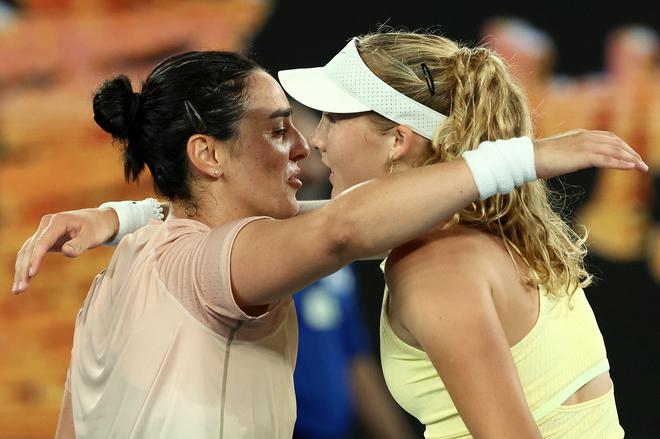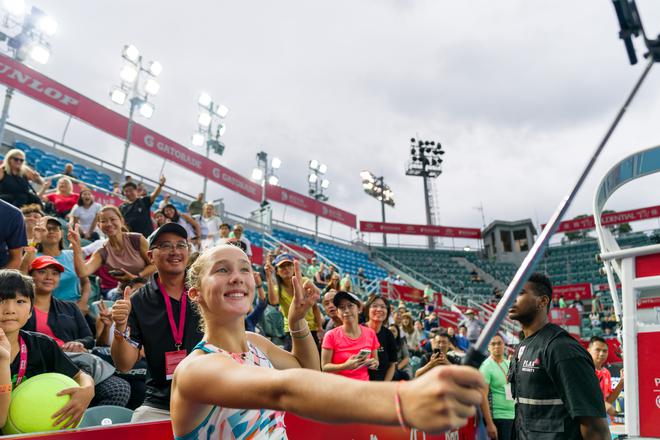The phenomenon of the teenage prodigy isn’t new to women’s tennis. Since 1887, when Lottie Dod won the first of her five Wimbledon singles titles at just 15, several precocious talents have turned heads with a swing of their racquet.
The Open Era, which began in 1968, has seen Tracy Austin, Monica Seles and Martina Hingis win Grand Slam crowns before their 17th birthday, and Steffi Graf, Arantxa Sanchez Vicario, Serena Williams and Maria Sharapova achieve Major success before turning 18.
Hana Mandlikova and Emma Raducanu were 18 when they broke through. Evonne Goolagong Cawley, Chris Evert, Iva Majoli, Svetlana Kuznetsova, Bianca Andreescu, Iga Swiatek and Coco Gauff had to wait longer, but managed the feat before blowing out 20 candles on their birthday cake.
Capturing public imagination
There have been other teenagers without the same level of early Grand Slam success — but they exerted a similar hold on the public imagination in their time.
Jennifer Capriati was the youngest player to enter the top-10 at 14 and an Olympic champion at 16 (Barcelona 1992). But she endured personal challenges in her teens and took a break from the Tour. She made an inspiring comeback to win three Majors in her mid-20s and climb to the top of the rankings.
Andrea Jaeger rose to World No. 2 at 16, making five semifinals and two finals in Grand Slam events in the early 1980s. But her career was cut short by injury. Anna Kournikova, a contemporary of Hingis, was another who was forced into early retirement because of injuries.
The incidence of injuries and stress-related burnout among teenagers forced the WTA into action in the mid-1990s. It introduced measures, which included limiting the number of tournaments teenagers could play, directed at “reducing burnout and increasing longevity”.
Perhaps as a consequence of these measures, and more concretely because of the prevailing competitive dynamics at the time, the period between the 2005 Australian Open and 2019 Wimbledon had no teenage first-time Major winners. Andreescu, Swiatek, Raducanu and Gauff ended that phase, and now another gifted teen has ambitions of joining them.
Mirra Andreeva, who turned 16 in April, has played in the main draw of four Slams — on each occasion, it has needed a top-25 player to stop her. She has already made two trips to the second week. After losing the junior final at last year’s Australian Open, Andreeva reached the third round at Roland-Garros, the fourth round at Wimbledon, the second round at the US Open and the fourth round at the ongoing Australian Open.
Statement of intent
Both in Paris and London last year, she came through qualifying, making those runs that much more impressive. This year’s Australian Open was her most empathic statement of intent; while her Wimbledon showing was remarkable for someone new to grass, it was her Melbourne performance that suggested she has the mental wherewithal to go deep at the Majors.

Andreeva beat Bernarda Pera in straight sets in her opening match, overwhelmed her tennis inspiration Ons Jabeur — a three-time Grand Slam finalist — in the second, and saved a match-point before beating Diane Parry in the third round. She also took the first set against 2021 French Open champion Barbora Krejcikova, whom she had beaten twice before, before falling short in her bid to become the youngest Australian Open quarterfinalist since Hingis in 1997.
Where the win over Jabeur showcased Andreeva’s variety and tennis IQ, the victory over Parry shone a light on the World No. 47’s mental resilience.
Against the creative Jabeur, Andreeva, who can slice and dice it herself, made a strategic decision not to match her idol. Until she felt like she could afford to — like the backhand drop shot to earn set-points in the first set of the 54-minute 6-0, 6-2 hammering.
“I’m also not very bad at dropshots [but] I decided at first not to do a lot of dropshots,” Andreeva said. “I tried to beat her from the baseline. It was just the momentum when I decided to do a couple of drop shots. I think she’s still better than me in this, but I will improve!”
Andreeva’s ability to problem-solve has earned comparisons to Hingis, the youngest singles Grand Slam champion in the Open Era, at 16 years and 117 days.
“I actually watched a lot of her matches,” Andreeva said. “I heard that people compare me to her. I think we’re a bit different in a way that she plays smart, she’s a bit more aggressive, not afraid to go to the net. Me, I prefer to stay on the baseline. If I have an opportunity, I go to the net of course… but I mean, I can finish the point on the baseline.”
Mental fortitude
Andreeva’s mental strength during the win over Parry caught the eye of another former No. 1, Andy Murray. “Andreeva down 5-1 in third. Commentator ‘she really needs to work on the mental side of her game. She’s too hard on herself when she’s losing’ ... 30 minutes later 7-6 Andreeva wins,” Murray posted on X, formerly Twitter. “Maybe the reason she turned the match around is because of her mental strength. Maybe she turned the match around because she is hard on herself and demands more of herself when she’s losing/playing badly? Winner.”

Andreeva, a self-confessed Murray fan, was delighted with the compliment. “Yeah, that’s true… Maybe being harsh on myself actually helped me. This harshness, let’s say, helped because I am not very positive in my head usually. I was saying not good words to myself. I think that helped me, that pushed me.”
Andreeva’s ambitions are giant — she doesn’t want to stop playing until she has won 25 Major titles — which perhaps explains why she is not impressed with what she has done so far. “I don’t think that I achieved something incredible,” she said after her Melbourne exit. “Fourth round is nothing. Maybe if I win a Slam… I have time still to do that, I hope.”
Still chasing her first WTA singles title — she has six on the ITF circuit — Andreeva is next scheduled to play the WTA 1000 events in Doha and Dubai in February. Until she wins something of note in top-flight tennis, questions on whether she is the real deal will linger. But at least one former World No. 1 thinks the answer is obvious.
“I think everybody in tennis and the players know she is the real deal,” Lindsay Davenport, a three-time Major titlist, told the Tennis Channel. “She is coming, she’s going to be in the conversation of being a Grand Slam champion. You just never know when the player reaches that point in their own mind. Sometimes, it is this young. Sometimes it might take until 17 or 18. Gauff won a Major at 19, but we started talking about her when she was 15. Maybe it is now for Andreeva.”







